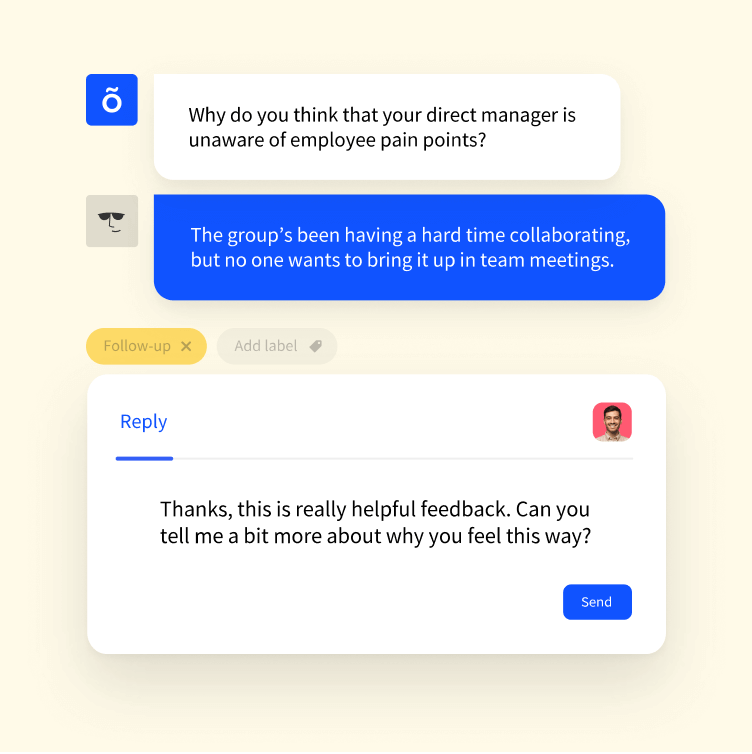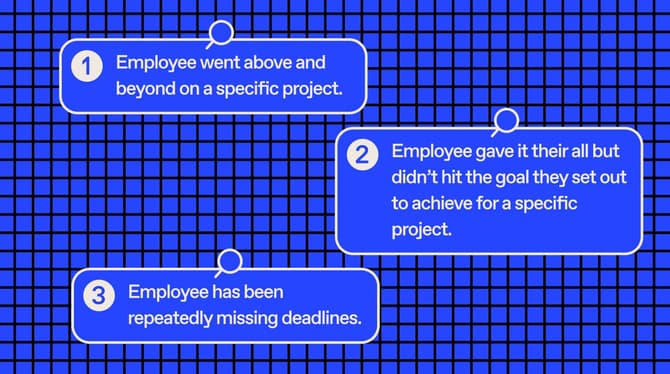At any stage of your career, the managerial role will require you to wear many different hats that each serve their own unique purpose. Some hats are better suited for the interpersonal nature of the role, other hats require your technical skill.
The challenge for many managers becomes not only improving your competencies under each hat but also knowing when to switch hats based on individual employees' needs.
In this article, we will discuss the 4 hats managers must wear and when to use each one when managing a team. Our team of managers at Officevibe was trained on this topic through Edgenda, and this article is based on the amazing lessons they shared with us!
Exclusive online summit
·
May 23 2024
Moments that matter: how to seed great work
What's in this article
The 4 hats every manager must wear
1. The expert hat
Putting this hat on means you’re stepping outside your role as a manager, and back into the role of expert contributor in order to support your team.
Imagine your new hire is about to touch some code that only you know how to properly write. While you’d like them to be able to eventually do it on their own, you’ll probably need to step in as the expert to first show them how to get it done properly.
It is equally important to know when to take your expert hat off! There will be other times when you’ll have to let go of the expert work you enjoy doing in order to give those on your team an opportunity to learn, shine and grow.
If you’re deciding whether or not to step in as an expert, ask yourself:
- Does my team have the right training and knowledge to perform the task the way it needs to be done? If not, stepping in to show them how it's done as the expert may be needed.
- What are the risks of me not stepping in to assist as the expert?
- How will it benefit someone else on my team to take on this work? Sometimes taking your expert hat off and giving other people a chance to do the work will help them grow.
2. The supervisor hat
Putting your supervisor hat on is needed when you’re required to monitor your employee’s work. For example, if you want to see how your team member is doing on a presentation, you may step in to observe and later give some feedback. It can also be used to check in on your team’s objectives and see how they are progressing against their goals.
When you wear your supervisor hat, you are present for your team to answer questions as it relates to their job, perform quality assurance on their work, and review the larger body of work before it goes out to clients or the organization.
To know when to use your supervisor hat:
- Ask your team when they would like supervision on their work. Some team members will enjoy autonomy from the start, while others will feel more comfortable with the support of supervision. Agree on touchpoints and stick to them.
- When your team is doing something for the first few times, supervising them throughout the process can help as you will be able to provide useful feedback while clarifying your expectations.
- How well do people on your team understand the processes required? If there is low understanding, you’ll need to put on the supervisor hat. If people seem to know how to do the work well, keeping your supervisor hat on may be perceived as micromanagement!
3. The leader hat
When you lead your team, you’re trying to help them work together towards your company’s vision, mission, and values. Mobilizing them in this way means inspiring them to work hard and stay motivated under all sorts of circumstances.
If your team is going through major changes or feeling unmotivated, it may be time to put on your leadership hat. Help them see the bigger picture. Remind them of their purpose. Show them their impact. Lead by example.
If you notice your team struggling as they transition to remote work, use your leader hat to guide them through this new territory. This means unifying your team and shedding light on their new path so they can find their footing.
Before putting on your leader hat, consider:
- What motivates each of your team members? By understanding each of their “Whys”, you’ll be able to better understand what’s in it for them, and use this to drive their internal motivation.
- Show your team that you care. People feel inspired to work harder when they feel like their manager has their best interest at heart. Do this by getting to know each of them personally through 1-on-1 and team meetings.
- Lead by example. Your team will look at your actions for guidance so it's important to model the behavior you wish to see. When challenges are presented on your team, it's important to switch on this leader hat.
4. The coach hat
As a manager, one of the best things you can do to help your team develop is to coach them.
Imagine your employee comes to you with a question about their work. While it may be quicker to give them the answers, asking them thoughtful coaching questions can often help your employees reflect and come to their own conclusions. This is what leads to their growth. Coaching in the mindset of employee development requires soft skills such as active listening, perception and empathy. It also requires patience.
You might also want to wear your coaching hat when an employee has a fixed perspective on something. Whether it's a conflict with a colleague or they are attached to a certain way of work, it's your job to help employees gain new perspective. You can do this by asking them to explain the situation from another point of view.
How to know when to put your coaching hat on:
- If you notice your employee always asking you for the answers rather than seeking out solutions on their own, use the GROW model to help you coach them towards finding their own solution.
- If your employees express interest or desire for personal development, put on your coaching hat and help pair them with a mentor in the area they would like to grow.
- Recognize when the coaching hat is not enough to help address poor performance. Sometimes your employee might need the support of a coach, and other times, they may need a more structured performance improvement plan.
3 key management skills to help you switch hats
There are three key factors that contribute to strong management, which all contribute to your ability to wear the above-mentioned hats at the right time. These factors include being present, owning your role as a leader, and creating trust within your team. Let’s review each of these!
1. Be present for your team to understand their needs and context
To be a great manager and understand when to switch your hats, you must be present for your team to truly understand your people and their context. Managers can get really busy and stuck in management meetings or strategic planning and employees don't always feel their manager's presence. But at the base, management is an interpersonal role. You can't know when to choose your different hats if you're only getting half the picture. Bottom line - spend time with your team.
To be more present for your team:
- Stick to your 1-on-1 routines. This is especially important with remote employees as they may not have that regular face time with you.
- Take pauses throughout the day when you’re getting distracted or frustrated so you can collect yourself and be present in a more productive way for your team.
- Pop into Slack here and there to let your employees know that you know you're busy, but you're still there for them.
- Take stock of the context and environment in order to understand which hat you’ll need to wear in any given situation.
2. Own your leadership style and work towards constant improvement
As a manager on your team, you must take responsibility for your leadership, especially when it comes to tasks like communicating objectives, conflict resolution, and delivering difficult feedback. In order to put on your leadership hat, you’ll have to craft a clear understanding of what leadership means to you.
While these parts of the role may be challenging at times, developing your own leadership style will help give you a framework to lead naturally.
To sharpen your leadership style:
- Find a mentor within your company whose style you admire.
- Be upfront about your management style and remind them that even when direct, your intention is to help them grow.
- Ask your team how they like to be led, what they need, and how you can improve for them.

Use free tools like Officevibe to collect feedback on your leadership style so you can constantly improve.
3. Build a foundation of trust with employees
In order to switch hats successfully without your team feeling defensive or confused, you need to build a foundation of trust. This will ensure that when you switch from a coaching role to a more direct supervising role, your team understands this shift and trusts that you have their best interest at heart.
Trust won’t happen overnight and will require deliberate action from you as a manager.
To help build trust with your employees:
- Use time in your 1-on-1s to check in with your employees and make sure their needs are being met at work.
- Give feedback that is meaningful and speaks concretely to people’s work and behavior to help build engagement on your team.
- Take action on the feedback you receive to demonstrate you are really listening to their concerns and needs.
Whether you're just starting out as a new manager, or you’re a seasoned professional, the role of a manager will require you to shift gears and stay sharply in tune with the needs of your team! This may require a little extra attention as working remotely presents new challenges, but with proper attention to switching your hats, you’ll have no trouble with the role of manager this new year.



